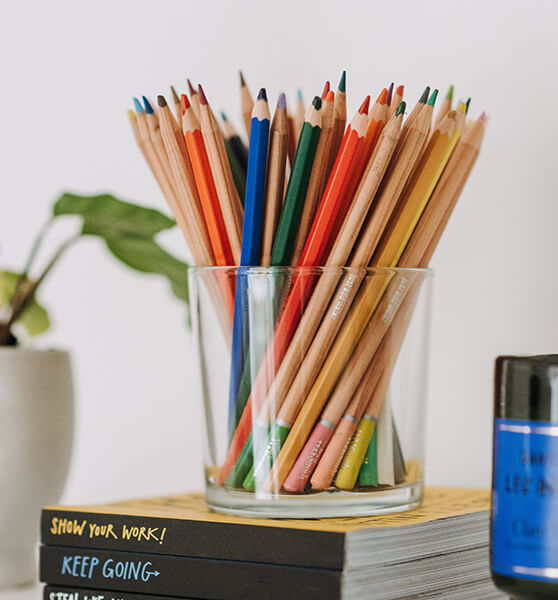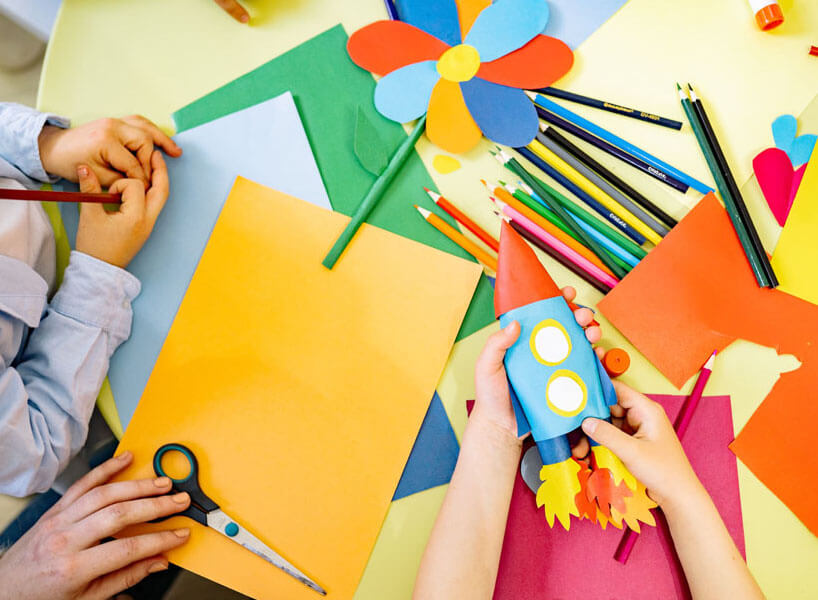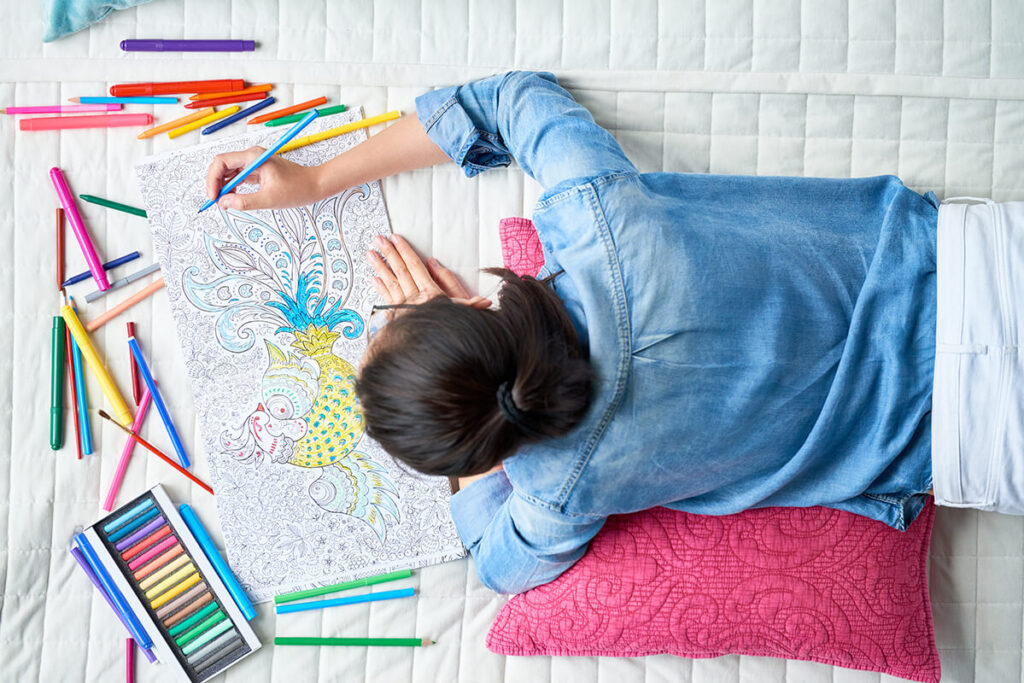Drawing has been a popular artistic activity since the 17th century. It’s an intrinsic human tendency ingrained in all of us. It is a rewarding form of creative self-expression that’s fun, relaxing, and therapeutic.
The art of drawing has mostly stayed the same since the Renaissance period. However, many drawing materials are available today, so anyone can start drawing quickly.
This drawing material guide by Jabay offers information on the different types of drawing materials and their uses. As an art and crafts manufacturer, we provide insights into drawing material qualities and safety standards.
What are the Essential Drawing Materials?
Whether you want to start drawing, nurture a young budding artist, or import drawing materials for resale, here is an overview of the essential drawing materials and instruments every artist needs.

1.Drawing Surfaces and Paper Pads
First, you need a surface or support to draw on. Drawing paper is available as single pads, loose sheets, or sketchbooks. If you are working on single sheets of paper, secure it to a drawing board or easel.
2.Drawing Pencils and Tools
Pencils for Drawing
Solid, easy to use, and erasable, a pencil is the ideal drawing instrument. It’s a versatile tool you can use in many different ways. In addition, drawing pencils come as sets that offer multiple hardness and tonal ranges, giving you the limitless capability to create textures and gradations.
Graphite and Charcoal Sticks
Solid drawing sticks are expressive and ideal for sketching, significant gestures, and shading.
Graphite sticks work great for fine lines and striking contrasts and highlights.
Charcoal sticks deliver rich marks that a pencil can’t make. Compressed charcoal is clean to use and creates sharp, dark lines. Willow charcoal glides smoothly on paper and blends easily.
Drawing Pens
Pens are waterproof and the go-to medium to create fine, flowing lines when sketching or drawing. There are different types of cells for drawings. Use fine liner, felt tip, brush, and water-based pens.
Colored Pencils and Other Media
Colored drawing materials come in handy when adding color to your drawings. Markers are great for this because they give you the control of a pen, but the ink flows like paint.
- Colored pencils are soft and have rich colors, enabling you to create extraordinary drawings. You can use them to draft, make sharp, definite lines, and add contrast.
- Composed of creamy pigment in vibrant hues, pastels are great for shading and detailed lines.
- Watercolors yield magical blends and translucent washes.
- For colored sketches, you can use pastels, chalks, or Conte crayons for drawing.
1.Various Erasers and Pencil Sharpeners
Erasers
An eraser is essential for correcting unwanted marks or lines. It also comes in handy for highlighting, blending, and lighting areas to create varying effects.
Sharpeners
Pencils and sticks grow blunt as you use them. It would be best to have a sharpener to keep graphite pencils sharp and a sharp craft knife or fine sandpaper to keep charcoal and carbon sticks on point. In addition, you can opt to use manual or electric pencil sharpeners.
2. Other Drawing Tools and Essentials
Blending Stumps
Stumps make shading and blending effortless and seamless. Use them to push and consolidate loose pigment onto the surface. They’re made of paper, and you can sharpen them to a point that allows you to apply touches like a pro.
Fixative
When using soft pigment media such as charcoal or carbon sticks, you must spray a fixative to protect your finished drawing from smudging.
Art Material and Portfolio Storage Solutions
You will also need a proper storage bag or case to organize and keep your drawing and sketching art supplies in good condition.
Choosing Quality Drawing Materials: What to Look For?
Not all drawing materials are created equal. They differ in the kinds of marks and effects they produce. In addition, some instruments are more suited to some paper types than others. Remember the following criteria to choose materials that deliver the desired results.
Choosing the Right Pencils for Drawing
Here are the factors to consider when selecting drawing tools such as pencils, charcoal sticks, and pens:

Hardness Rating
Drawing pencils have varying degrees of hardness. Each pencil has a label that indicates its hardness and softness level.
The pencil grading scale ranges from 9B to 9H. The higher the number preceding the B, the softer the lead and the more profound and blacker the mark it makes. The higher the number in front of the H, the more complex the information and the lighter the spot.
Most artists use soft pencils as they have a more excellent range of tones, and the mark they make is erased easily. Hard pencils are the go-to for light but clear-cut lines.
Erasability
Some drawing tools only erase easily, leaving streaks. Graphite pencils and sticks of willow charcoal rub out quickly, while ink pens are permanent.
The Kind of Mark Made
What kind of mark does the drawing tool make? Non-graphite pencils and charcoal sticks are versatile in producing deep dark tones and making subtle marks. A soft graphite pencil can also make a dark mark, offering a limited range of styles.
The Level of Coverage
How many marks would it take to cover a drawing pad? Wax crayons and charcoal sticks can quickly cover a sheet, making them ideal for quick poses. You can also cover a wide area using the side of a charcoal pencil. On the other hand, the tip of a graphite pencil or pen has limited covering power.
The Type of Grip
The drawing tool you have in hand determines the kind of grip you adopt. For example, you automatically get into the tripod grip when using a pen. If you hold a wax crayon or charcoal stock instead, you get into the overhand grip. A charcoal stick will force you to fine-tune your overhand grip as a beginner.
The Kind of Detail
When getting into drawing, using willow charcoal will teach you simplicity. Once you learn to simplify, you can experiment with graphite pencils and other media, encouraging you to understand detail.
Gesture Curves
Charcoal sticks and wax crayons are the way to make sweeping gestural curves. Sharpened charcoal pencils, soft graphite pencils, and brush pens also work well.
Selecting Erasers for Drawing
Erasers, too, are available in different types to choose from.
Most artists use a kneaded or putty eraser because it works for all media, including charcoal, and doesn’t leave marks or smudges. It’s very soft and malleable, so you can shape it to erase precisely and cleanly. This makes it perfect for adding highlights.
Plastic and vinyl erasers are incredibly dense and strong, so they don’t shed. You can use them to remove stubborn pencil and graphite marks. They also work well for making incised lines and patterns and adding texture.
Lastly, the standard rubber eraser is good enough for removing medium graphite pencil marks.
Finding Quality Surfaces for Your Drawings
There is a wide variety of papers for drawing. They differ in surface textures, weights, sizes, and other qualities. Here are the factors to have in mind when selecting drawing paper or sketchbooks:
Surface Texture
Drawing paper can have a rough, medium, or soft surface.
Most papers are cold-pressed and feature a medium texture that works well with most drawing media.
Hot-pressed papers have a very smooth surface. They are suitable for nuanced pencil media and pen and ink works.
Rough papers with a highly textured or pebbled surface are ideal for bold and expressive drawings using charcoal, pastel pencils, chalks, and soft graphite pencils.
Paper Quality
The best high-quality drawing paper is acid-free. This means that it doesn’t fade or disintegrate with time. Your drawings have been in good condition for a long time. Cheap paper that’s not acid-free is brittle, prone to yellowing, and deteriorates quickly.
Size
Drawing paper comes in many size options. Small sketchbooks are ideal for holding in your hand, bringing along everywhere you go, and for kids’ hands. Large sketchbooks offer enough space to tackle large or multiple objects but may force you to draw while seated.
Color
Plain white paper is best when using graphite pencils. Conté crayons look great on warm mid-color tones, while charcoal is best on mid-grey paper.
Weight
Thick paper with a 68 lb/100 weight (regular printing paper has a 20lb/75 gsm weight rating) is ideal for drawing. You can draw, rub, shade, and blend without the paper tearing or wrinkling. Heavier paper can handle multiple layers and wet media like watercolors and paint.

Matching Drawing Media and Paper Type
Your choice of paper also comes down to the drawing media you’re using. Here is an overview of the different types of drawing paper and what drawing implements work best on different types of writing:
Drawing Paper
This is a high-quality paper designed for drawing. It’s often used for graphics and finished works.
Best Media: Graphite, charcoal, soft and oil pastels, pen and ink, markers
Sketching Paper
Artists use a lighter version of drawing paper for sketching, drawing exercises, and quick studies.
Best Media: Graphite, charcoal pencils, colored pencils, chalks, oil pencils
Tracing Paper
Thin, transparent sheet for tracing, image overlays, and thumbnail sketches.
Best Media: You can trace with graphite, markers, or use ink pens.
Newsprint Paper
Inexpensive and the most commonly used paper by sketching amateurs and hobbyists. It’s prone to fading over time, though.
Best Media: Graphite pencils, charcoal, monochrome chalks, markers, oil pencils
Charcoal Paper
Lightweight paper that grants the user fine control when shading.
Best Media: Graphite, charcoal, chalks, pastels
Vellum Paper
This is translucent paper used for tracing and adding decorative elements.
Best Media: Graphite, colored pencils, chalk, pastels, markers
Layout Bond Paper
Semi-opaque paper is favored by comic artists, calligraphers, and designers. Many painters and artists also use it for tracing and sketching.
Best Media: Graphite, monochrome pencils, colored pencils, charcoal, chalk
Mixed Media Paper
Created for modern artists, it combines features of a vellum drawing surface and watercolor paper.
Best Media: Pencils, charcoal, chalks, markers, acrylic, watercolor, gouache, pastels, pens, inks, and more.
Toned Paper
Allows the use of a wide range of values and tones. It’s also ideal for placing shadows and highlights.
Best Media: Both dark and white media, from graphite to white pencils
Bristol Paper
Two or more sheets are joined together to create an adaptable paper with two usable sides: a smooth and vellum surface.
Best Media: Colored pencils, graphite, airbrush, pen, and ink on the smooth side. Airbrush, pastel, crayon, charcoal, graphite, colored pencil, and pen and ink on the vellum surface.
Marker Paper
The heavy paper can be used with markers without bleeding or feathering. The incredibly smooth surface also works well for blending.
Best Media: Designed for markers but can also work with graphite.
Pastel Paper
It is a double-sided paper, with one side having a textured surface and the other a silky finish.
Best Media: Pastels and also charcoal, monochrome, chalk, colored pencils
Watercolor Paper
This heavy, stiff paper is available in 90 lb, 140 lb, and 300 lb weights. It suits all kinds of drawing media, both dry and wet.
Best Media: Watercolor, pencils, gouache, liquid acrylics, chalks, monochromes, colored pencils, graphite.

Drawing Materials Safety Information
As you draw, you interact closely with the paper, pencil, eraser, and any other material you use. This means that the components in the drawing materials can be inhaled, ingested, or absorbed through the skin.
Safety is, therefore, a critical consideration for both kids and adults when selecting and using drawing materials. Many countries have specific requirements that art material manufacturers and suppliers should abide by.
For example, art materials in the United States should conform to the Labeling of Hazardous Art Materials Act (LHAMA), TRA, (M)SDS, and Prop 65 requirements. Drawings and other art supplies must bear an ASTM D-4236 conformance statement or a warning label on the package.
It’s essential to read the labels and check the Material Safety Data Sheet (MSDS) when buying and using any drawing material. Doing this helps you identify safe materials and educate on the safety precautions to observe.
How to Identify Nontoxic Drawing Materials for Kids
Nontoxic drawing supplies have the AP (Approved Product) label by the Creative Materials Institute (ACMI). On the other hand, the Caution Label (CL) mark alerts you of toxic or hazardous components.

Drawing Material FAQ
What are the Essential Drawing Materials?
Paper, pencil, eraser, and sharpener are the essentials for drawing. Most people begin their artistic journey with this simple beginner’s setup. You can try more materials as you build your skills.
What Drawing Materials Should I Get As a Beginner?
Drawing material sets are ideal when starting. These sets come with everything you need to get into drawing. A typical group has a sketchbook, pencils, sticks, an eraser, and a sharpener.
What Drawing Material is Not a Dry Medium?
Dry media include pencils, graphite sticks, charcoal, pastels, and crayons. They create marks that you can blend or rub out.
A wet medium contains pigment in liquid form so it flows onto a surface. Ink pens, paint, watercolor, and gouache are wet media.
Which Brand is Best for Drawing Supplies?
Strathmore, Faber-Castell, Arches, Prismacolor, Staedtler, Arteza, Winsor & Newton, and Derwent are many artists’ go-to quality drawing material brands.
How Do I Take Care of My Drawing Tools?
The most important thing is to keep your drawing implements clean and dry. Store them in a dry place and avoid exposure to extreme temperatures.
Conclusion
You don’t need fancy equipment to start drawing. You can explore different techniques and create intricate drawings with a pencil and paper or sketchbook.
Choosing high-quality drawing materials is crucial, though. Look for reputable companies that offer quality art supplies at reasonable prices.
Please get in touch with us if you have questions about drawing material or need an art supplies manufacturer.
